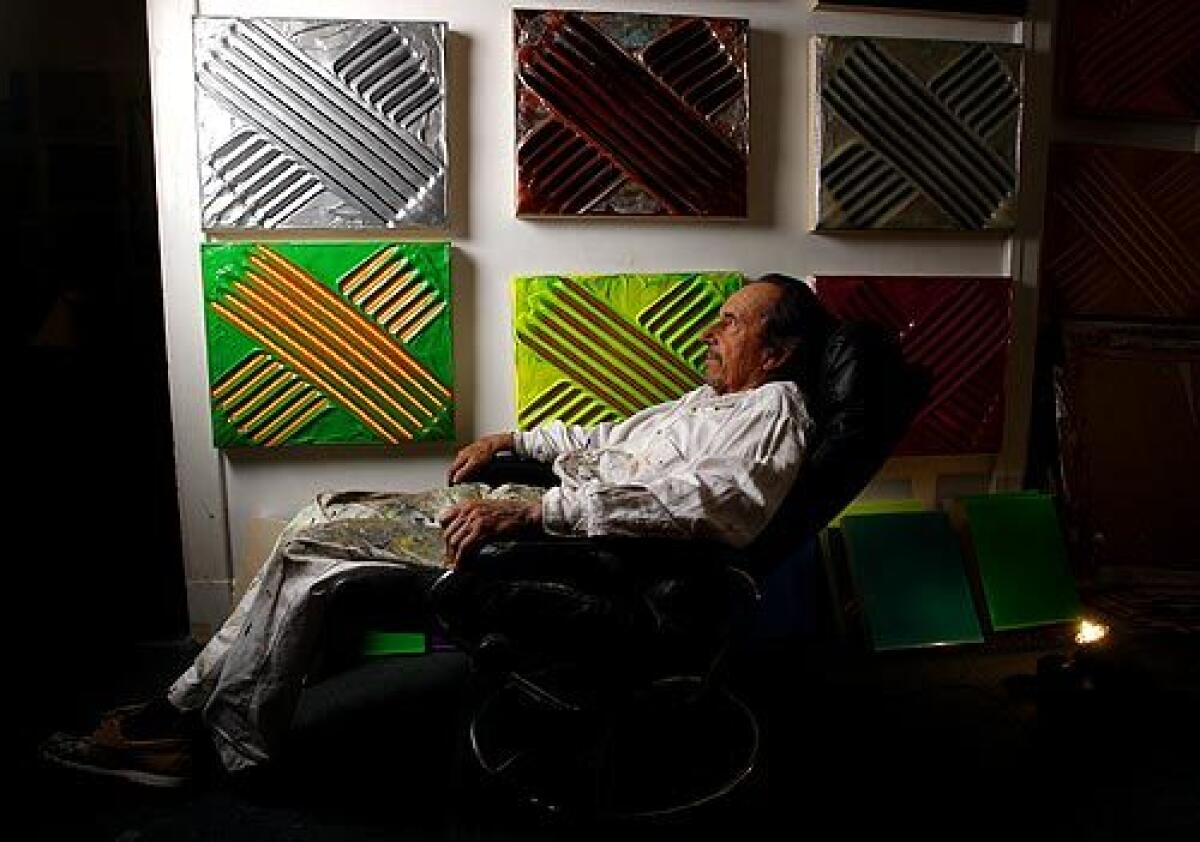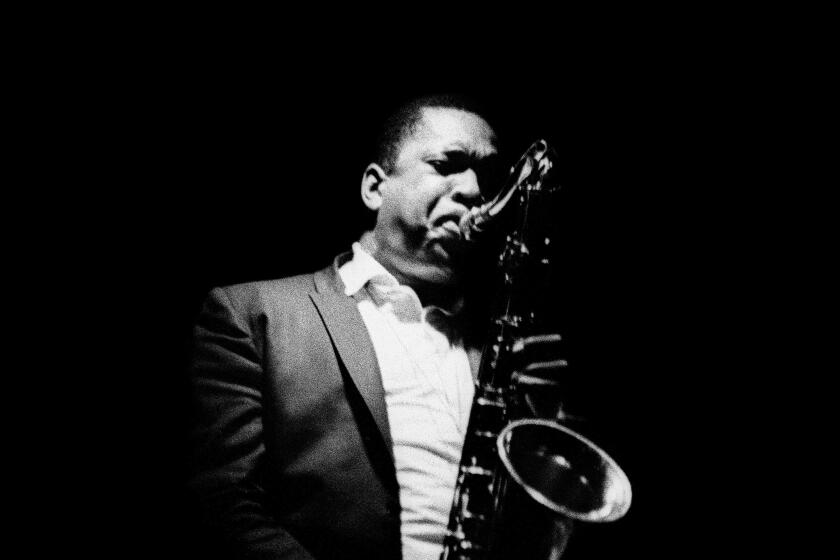After 25-year delay, Albert Contreras is on track

- Share via
Some artists know their calling from the get-go. They skip out of school and get started as quickly as possible. Others come to art late in life, after many years working unrelated jobs. Few artists do both.
But that’s exactly what Albert Contreras has done. Over the last 50 years, the 76-year-old Santa Monica painter has cobbled together an unusual two-part career -- interrupted by years as a city truck driver -- that has just come full circle.
In the 1960s, Contreras made a name for himself as a painter. After graduating from Hollywood High and serving in the Coast Guard, he used the GI Bill to take a year of painting and ceramics classes at Los Angeles City College. Then he hit the road, taking language courses in Mexico and studying at the University of Madrid in Spain before settling in Stockholm.
He ended up there on little more than a whim. Almost embarrassed by the simplicity of it, he says, “I went for the women. I fell in love with the blond, blue-eyed girls of Sweden.”
Living there from 1960 to 1969, he became a highly regarded artist. He had five solo shows. Collectors bought his austere, often single-color paintings. And curators from such prestigious institutions as the Stockholm Museum of Modern Art, the Malmö Konsthall and the Göteborgs Konstmuseum secured his works for their permanent collections.
Then, in 1972, Contreras stopped painting.
“Here is what happened,” he says with the directness of someone who knows what he’s talking about. “I was paintings like a lot of Minimalists at the end of the ‘60s: reductive. We wanted to finish off painting. I painted myself to where I wanted to disappear. And I succeeded! I had come to the end of the line, and it was all over. There was no use for me to paint anymore.”
Blue-collar work
So after moving back to Los Angeles (by way of New York), he shut down his studio and went to work for Santa Monica. For the next 20 years, he was a full-time employee, driving garbage trucks, operating heavy equipment and working as a crewman on a front-end skip loader, resurfacing asphalt streets. Thoughts of painting may have been lurking in the back of his mind, but art no longer played a major role in his life. He liked the no-nonsense pragmatism of the work-a-day world and especially enjoyed operating the heavy equipment, almost, he says, as much “as a kid playing with trucks.”
As an artist, Contreras is humble and unpretentious and not at all impressed with himself. He describes his lengthy hiatus from painting as if he were Rip Van Winkle, saying, “I fell asleep. And then I woke up 25 years later.”
After retiring in 1992, Contreras spent five years in therapy. In 1997, he was done with that and went back to painting. “I don’t know exactly how I took up painting again. One day I said, ‘You know, I think I can paint again.’ ”
Speaking softly, he continues, “Maybe some part of stopping painting was losing faith in myself. It had to be. Therapy helped me get some self-esteem. That self-confidence helped open the door.”
Then excitement returns to Contreras’ voice and the words again fly out fast: “I picked up exactly where I had left off, making monochrome paintings with little gestures in them. The first paintings I made were nearly 30 years late.” Almost screaming, he adds, “Now I’m doing fast-forward!”
He bought hundreds of buckets of brightly colored acrylics, ordered canvas by the yard and hired specialists to stretch it over hand-built panels. He lashed together plastic trowels and metal putty knives to make odd spatulas that let him slather on paint by the pound, swiftly and thickly.
He turned his small studio apartment into a one-man factory. He converted cupboards and closets into storage spaces. He transformed the kitchen table into a laboratory where he mixes pigments and experiments with the physical properties of various paints. A pair of easels occupies the main room. Bookshelves stand in as drying racks. Everything else ends up on the floor, in tidily piled boxes, bags and canisters. There is barely enough room to sleep, eat or sit, but that suits Contreras just fine. His painting is all consuming, leaving little time or energy for art-world schmoozing.
His focused fury quickly paid off. In December 2000, a critically acclaimed solo show, organized by curator Max F. Schultz, opened at USC’s Fisher Gallery. In 2001, he had two solo shows at the Daniel Weinberg Gallery in Los Angeles and his New York solo debut at the Bill Maynes Gallery. A jam-packed survey, with 96 paintings from 2002 to 2005, followed at the Fisher Gallery in 2005. And a solo show at the Peter Mendenhall Gallery in March featured paintings made from new, translucent pigments in a rainbow of kinky tints.
Mendenhall made only one studio visit before deciding to represent Contreras and schedule a show. “Albert is singular,” he says, “he is obsessive and eccentric in a good way and that comes through in his work. His paintings are an extension of him. I’ve never seen anything like them.” Another solo show is scheduled for April.
Contreras paints like a laborer in love with his work. He makes far more paintings than he sells and says, with a mischievous smile, “I have paintings coming out of my ears.” (His prices range from $2,500 for small pieces to $15,000 for large works and multi-panel arrangements.)
Busy with exhibitions
With little room for storage, he has been donating pieces, usually in groups of 24, to university galleries and museums across the country, including USC, Syracuse University, Howard University and the University of Pennsylvania. Today, he is far more eager to talk about what is happening in the studio, particularly the shellac-based inks he is using, than about his impressive exhibition schedule. Last year, he made three trips to Sweden for four solo shows. All were set up by Peter Freudenthal, a Swedish artist who knew Contreras in the ‘60s and was so struck by his new works that he had to see more.
The Swedish exhibitions focused on his new paintings: elaborately patterned abstractions made up of juicy rectangles of eye-popping colors on glitter-sprinkled grounds or swift, X-marks-the-spot gestures in jello-like expanses of acrylic. In most, screeching colors collide and harmonize, boggling the mind and satisfying a deep desire for out-of-step symmetry.
The largest of these shows, at the Lindingo Konsthall, juxtaposed his dazzling Pop paintings with his works from the 1960s: darker, more tight-fisted abstractions that wear their commitments to Minimalism on their sleeves. The pairing takes his career full circle, uniting his fresh-out-of-school works with his post-retirement paintings in an idiosyncratic yet consistent whole.
Selma Holo, director of the USC Fisher Museum of Art, says: “Albert is an emblem of the persistence of the artist’s identity over decades. In spite of his very serious effort to disconnect from art, the driving creative force that characterizes him emerged powerfully in his later years.”
He concurs. “Looking back over the last 11 years of painting,” he says, “I’m positive that I was painting ‘catch-up,’ [making art] I’m sure I would have done during the 25 years away from it. There was always an urgency to move ahead quickly on the next variation of geometric abstraction, to ‘catch-up’ to where I would be if I never stopped painting in the first place.”
In terms of chronology, Contreras’ latest paintings are his mature works. But they are so exuberant, optimistic, even goofy in their joyousness that they come off as the work of an artist animated by the excitement of just getting started at something filled with immense possibility.
“What I’m happy about now is that ideas are cooking in my mind,” he says. “I haven’t really reached my peak. I haven’t caught up to where I can go yet. I haven’t caught up to the end. I gotta catch up.”
More to Read
The biggest entertainment stories
Get our big stories about Hollywood, film, television, music, arts, culture and more right in your inbox as soon as they publish.
You may occasionally receive promotional content from the Los Angeles Times.










